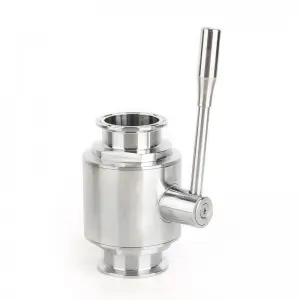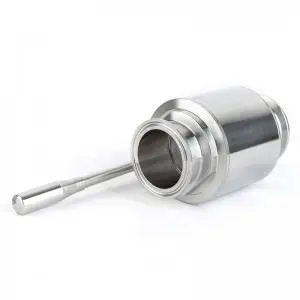Sanitary ball valves are widely used in different industries due to their ability to provide reliable and efficient fluid control. Designed for hygienic applications, these valves are ideal for use in the food, beverage, pharmaceutical and biotechnology industries. In this guide, we will provide you with important information about the use of sanitary ball valves, including their product descriptions, operating environments and precautions.
Product Description
Sanitary ball valves are designed for automation and manual operation. They can be operated by actuators such as electropneumatic actuators or manual rotary piston actuators. Axial movement of the actuator pushes the valve into the 90-degree position, allowing it to open or close. There are three types of actuators for sanitary ball valves: manual multi-position handles, electric actuators and pneumatic actuators.
These valves are made of high quality materials, 304/316L for steel parts in contact with the medium and 304 for other steel parts. The surface roughness of the flow-passing parts of the valve is Ra≤0.8, and the outer surface roughness Ra≤1.6. Wetted seals are made of PTFE or EPDM, while other seals are made of PTFE or NBR.
use environment
Sanitary ball valves are ideal for hygienic environments where fluids are sensitive to contamination. These valves are designed for easy cleaning, making them easy to sanitize and sterilize. They are commonly used in the food, beverage and biotechnology industries, where strict hygiene requirements are crucial. Sanitary ball valves are also used in the pharmaceutical industry where a sterile environment is critical.
Precautions for use
When using sanitary ball valves, it is important to follow the operating guidelines provided by the manufacturer. Failure to follow instructions may result in valve failure or damage. It is also important to ensure that the valve is compatible with the intended application. Using the wrong valve may result in fluid contamination or valve damage.
Regular maintenance is essential to ensure efficient and reliable operation of sanitary ball valves. Maintenance should include regular inspection, cleaning and replacement of worn parts. If the valve shows signs of wear or damage, it should be repaired or replaced immediately.
In conclusion, sanitary ball valves are essential for fluid control in sanitary environments. Reliable, efficient and easy to clean, they are ideal for the food, beverage, pharmaceutical and biotech industries. When using sanitary ball valves, it is important to follow operating guidelines, ensure compatibility with the intended application, and perform regular maintenance. By following these guidelines, you can ensure your sanitary ball valves will perform efficiently and reliably for years to come.


Post time: May-23-2023
